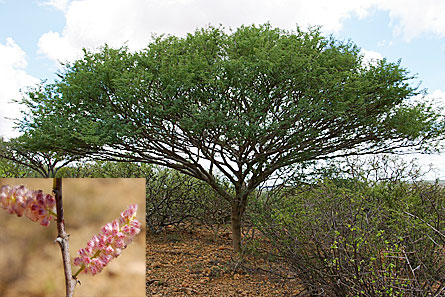Botanists couldn’t see the forest or the trees.

An acacia in northern Africa that grows six meters tall and dominates the landscape across an area almost three times the size of Rhode Island is new to science.
“It’s astounding,” says David Mabberley of the Royal Botanic Gardens in Kew, England. He summarizes the findings in the April 24 Science, though the tree was officially named Acacia fumosa online in the Nordic Journal of Botany in September 2008.
Finding a new species in itself isn’t such a surprise, he says. Scientists describe and give Latin names to some 10,000 new organisms a year. About 2,350 of these are flowering plants, with a new one from Africa appearing on average every weekday. Many of these new names go to plants that have been languishing misidentified or unidentified in collections, Mabberley says, and the complete surprises are typically uncommon plants or those that have tiny ranges.
But no herbarium specimens or botanical mentions of the new acacia existed, even though it’s widespread in its homeland, says Mats Thulin of Uppsala University in Sweden, who named the plant. He has named several hundred plants but never seen a case like this.
Science got such a shock from the tree because the acacia grows in Ethiopia’s Somali National Regional State, or Ogaden. Though politically part of Ethiopia, the sparse population of the region is mostly ethnic Somali, Thulin says. The Ogaden National Liberation Front is fighting for independence and has made traveling to the region perilous.
Thulin, who spent 18 years as editor of Flora of Somalia, had never visited Ogaden until 2006, when he joined a German zoologist who had arranged to study antelopes there.
“What happened to us several times both in 2006 and 2007 was that a group of rebels was suddenly standing on the road with machine guns directed toward us,” Thulin says. The scientists carried no weapons and had put a sign on their car saying so. Each time, after an hour or two of questioning, the armed party let them go. “An American, an Ethiopian or someone working for the Ethiopian government would have been in big trouble,” he says.
Almost immediately on seeing the acacia, Thulin says, he recognized it as an unknown species. It had unusual, smooth, gray bark, for example. On a later trip, he discovered that it burst into pink, sweet-smelling blooms during the dry season, when no leaves were on the trees. Its relatives bloom in yellow or creamy flowers during the wet season.
With a bit of travel and some help form Google Earth, Thulin realized how widespread the acacia is in its arid habitat. The tree provides vegetation in a landscape too dry for perennial grasses. And, like other acacias, has glands where ants sip nectar, so there may be a tree-insect mutualism.
Finding another such surprise may not be too likely, according to Tom Daniel, botany curator at the California Academy of Sciences in San Francisco. New species, yes. Plenty to name. But something this widespread that scientists haven’t seen — “This is pretty unusual,” he says.







